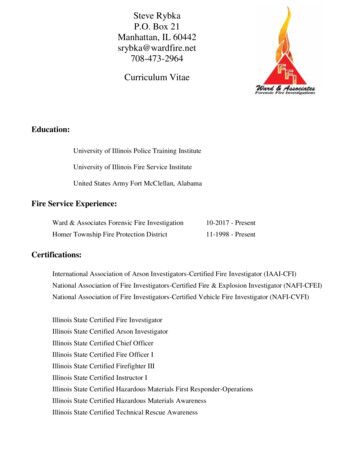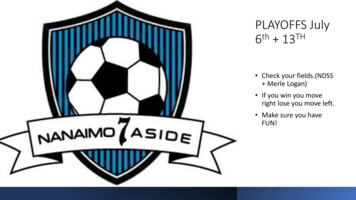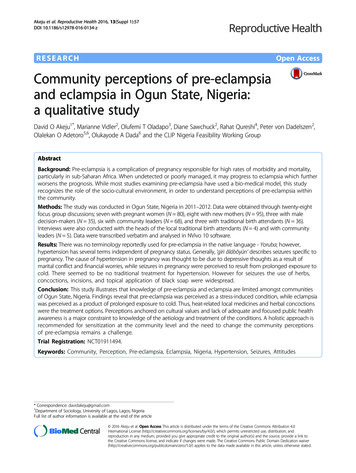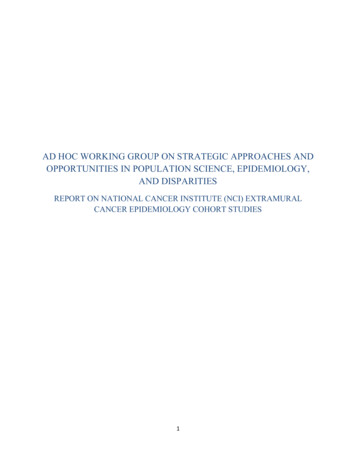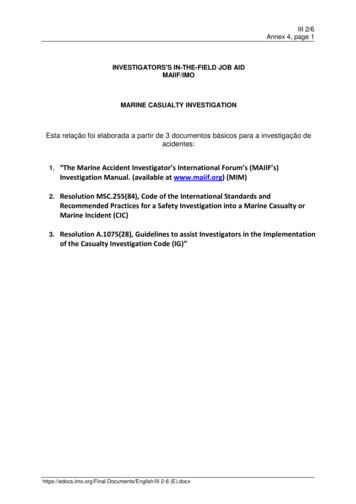
Transcription
III 2/6Annex 4, page 1INVESTIGATORS'S IN-THE-FIELD JOB AIDMAIIF/IMOMARINE CASUALTY INVESTIGATIONEsta relação foi elaborada a partir de 3 documentos básicos para a investigação deacidentes:1. “The Marine Accident Investigator’s International Forum’s (MAIIF’s)Investigation Manual. (available at www.maiif.org) (MIM)2. Resolution MSC.255(84), Code of the International Standards andRecommended Practices for a Safety Investigation into a Marine Casualty orMarine Incident (CIC)3. Resolution A.1075(28), Guidelines to assist Investigators in the Implementationof the Casualty Investigation Code (IG)”https://edocs.imo.org/Final Documents/English/III 2-6 (E).docx
III 2/6Annex 4, page 2Introduction to the Job AidThis Job Aid's primary function is to provide in-the-field guidance for new investigators in theperformance of their duties. It provides a comprehensive bullet point check list but there is noexpectation that investigators will need to complete every step for every case as each incidentis unique in its investigative requirements.The guidance is extracted from, or based upon, information contained in these three principalsource documents:1. The Marine Accident Investigators' International Forum's (MAIIF's) InvestigationManual. (available at www.maiif.org) (MIM)2. Resolution MSC.255(84), Code of the International Standards and RecommendedPractices for a Safety Investigation into a Marine Casualty or Marine Incident (CIC)3. Resolution A.1075(28), Guidelines to assist Investigators in the Implementation of theCasualty Investigation Code (IG)New safety investigators should be familiar with the contents of these three documents beforegoing into the field. This Job Aid acts as an aide memoire of the necessary actions andconsiderations at each stage of the investigation. If there is any doubt about what is requiredthe appropriate source document, which is referenced in the text as MIM, CIC or IG, should beconsulted.The Job Aid covers the investigatory stages up to and including the field phase. The sourcedocuments should be referred to for detailed guidance on the later investigatory stages ofanalysis, reporting and the formation of safety recommendations.The Job Aid covers the stages in chronological order and its sections are colour coded to makeit easy to use in the field.1.2.3.4.5.1Actions on NotificationPreparing to go on SiteArriving on Site/Site ManagementEvidence CollectionPreliminary AnalysisAnnex 1 - SHELLAnnex 2 - Areas to be ExaminedTable of Contents2Job Aid ‐ Actions on er information .Potential sources of information.Typical information required.Consider level of inquiry .Notify others .SISs .Interested parties .Superiors – press office – media .3Job Aid ‐ Preparing to Go on Site3.1Forming the Investigation Team .https://edocs.imo.org/Final Documents/English/III 2-6 (E).docx
III 2/6Annex 4, page idence Preservation .Preserve the Site (MIM 1.7).Preserve the Evidence (MIM 1.7) .Electronic.Human.Documentary.H&S Risk Assessment (MIM 1.3.7.1, 2.3; IG 5.3.1.2) .Equip the Team .PPE .Investigation Equipment .Logistics .4Job Aid – Arriving on Site/ Site Management4.14.24.34.4H&S Dynamic Risk assessment (MIM 2.3; IG 5.3.3) .Meeting Key People – Coordinating/Cooperating (IG 5.3.2) .Initial Site Survey (MIM 2.2.3, IG 5.6) .Dealing with the media .5Job Aid – Evidence al Aide Memoire ‐ SHELL .Evidence Collection ‐ Human .Fair Treatment (MIM 2.1.10) .Identify Witnesses/Interviewees (MIM 3.5.2) .Plan interviews (MIM 3.5.1, 3.5.2) .Conduct Interviews (MIM 3.5.4) .Evidence Collection – Physical (MIM 2.4.2) .Evidence Collection – Documentary .Evidence Collection – Electronic .6Preliminary Analysis (MIM 4.2.5, IG 5.11)6.16.26.3Stage 1 ‐ Sequence of events (MIM 4.3.1) .Stage 2 ‐ Identify 'accident events' (MIM 4.2.5.3, IG 2.1).Stage 3 ‐ Analyse 'accident events' (MIM 4.3.3) .7Annex 17.1SHELL .8Annex 2Interview ‐ Areas to be examined and information to be gained .8.1INFORMATION FOR EVERY CASUALTY .8.1.1General information.8.1.2Ship related information .8.1.3Particulars of people involved in incident .8.1.4Particulars of sea state, weather and tide .8.1.5Particulars of the incident .8.2SHIPBOARD ISSUES (IG APPENDIX) .8.2.1Training and experience.8.2.2Shipboard organizational structure and processes.8.2.3Nature of Tasks .8.2.4Activities prior to occurrence .8.2.5Work period/rest period/recreation pattern .8.2.6Living conditions and shipboard environment .8.2.7Physical health .https://edocs.imo.org/Final Documents/English/III 2-6 (E).docx
III 2/6Annex 4, page .78.88.98.108.118.12Mental Health .Working relationships .Employment conditions.Safety policy .Staffing levels .Standing orders .Level of automation and reliability of equipment.Ship design, motion/cargo characteristics.SHORESIDE MANAGEMENT ISSUES (IG APPENDIX) .Management policies and procedures.Scheduling of work and rest periods .Assignment of duties.Shore‐ship‐shore support and communications .Voyage planning and port call schedules.Recreational facilities .Contractual and/or industrial arrangements and agreements .National/international requirements.NAVIGATION ACCIDENTS .FIRES AND EXPLOSIONS .CARGO SHIFT INCIDENTS .FLOODING .FOUNDERING .LIFESAVING APPLIANCES AND EVACUATIONSTRUCTURAL/MACHINERY/EQUIPMENT FAILURE.SHIP LOST OR MISSING .ACCIDENTS INVOLVING ENCLOSED/CONFINED SPACEShttps://edocs.imo.org/Final Documents/English/III 2-6 (E).docx
III 2/6Annex 4, page 522.1Job Aid - Actions on NotificationGather informationGather information to be able to classify the accident, assess its significance and decide onappropriate response.2.1.1 Potential sources of information Flag State(s) and coastal States involved (contact details available in the GlobalIntegrated Shipping Information System (GISIS) Contact Points module); 24-hour contacts for the investigating body in each Member State (GISIS ContactPoints module or MAIIF website); National authorities involved, e.g. maritime Administration, coastguard, portauthorities, police (inc. VTS), and other emergency services (GISIS Contact Pointsmodule); Ship and company (contact details from GISIS Shio and Company Particularsmodule, Sea-web, SiReNaC, EQUASIS); VDR, ECDIS, GPS information resources, e.g. MAIIF/MAIB VDR Resource; AIS information sources, e.g. AISLive, SafeSeaNet; Environmental/hydrology conditions – National Meteorological Offices; Marine casualty information database(s), e.g. GISIS Marine Casualties andIncidents module, EMCIP or national database; IMO Conventions, Codes and Regulations; Nautical publications, e.g. almanacs, charts, tidal data, pilot books; Media – monitor any media coverage of accident and possibly record2.1.2 Typical information required Source of notification; Time and date of notification; Time and date of marine casualty or incident; The name of the ship(s), ship type, and its flag State;https://edocs.imo.org/Final Documents/English/III 2-6 (E).docx
III 2/6Annex 4, page 62.2 Name and contact details of owners and operators, the ship(s), the shippingcompany and other points of contact as may be applicable; Name and contact details of ship agents, if applicable; The IMO or ship number; The nature of the marine casualty; The location of the marine casualty, including latitude and longitude; The number of any seriously injured, missing or deceased persons; Consequences of the casualty to individuals, property and the environment; A brief description of the casualty event(s); The identification of any other ship or structure involved; Each ship's condition and intended movements; Contact details of anyone with information about the casualty; Details of VDR/SVDR, where fitted, and if the VDR data has been saved; The weather conditions on site;Contact information for the competent Authority of any Substantially InterestedState, and their investigation body if applicable; Contact information and action taken by local first responders; Contact information for cargo details and location, e.g. loading company.Consider level of inquiryIs casualty a Very Serious Casualty (Definition CI Code 2.22)? YESo Marine Safety Investigation to be conducted NOo Decide on level of investigation and or appropriate response– consider:oThe seriousness of the marine casualty or incident;ooooThe type of ship and/or cargo involved;The potential safety value that may be gained by conducting an investigation;The public profile of the casualty or incident;Whether the casualty or incident is part of an identifiable trend, e.g. from GISISdatabase analysis;The potential (as opposed to actual) consequences of the casualty or incident;ohttps://edocs.imo.org/Final Documents/English/III 2-6 (E).docx
III 2/6Annex 4, page 7oooooooThe extent of resources available and projected to be available in the event ofconflicting priorities, including the extent of any investigation backlog;Any risks associated with not investigating;Serious injuries occurring to crew and/or passengers and/or third parties;The pollution of environmentally sensitive areas;Ships subject to significant structural damage;The disruption, or potential disruption, of major port operations or otheractivities;Whether another administration will be investigating.Decide:2.3 Marine Safety Investigation; More information needed (Preliminary Assessment); or, No investigation necessary (MIM 1.5)Notify othersNotify other Substantially Interested States (SISs)(Definition CI Code 2.20) and InterestedParties (IPs) (definition CI Code 2.7)2.3.1 SISsThe flag State (s) of the ship(s) involved and/or the coastal State has an obligation to notifyother SiSs (CI Code Ch. 5) with as much of the following information as is available: flag State(s) of the ship(s); IMO identification number(s); nature of the marine casualty; location of the marine casualty; date and time of casualty; number of seriously injured or deceased persons (and nationalities); consequences of the marine casualty to people, property and/or environment;THEN: Discuss and decide which State will be the Marine Safety Investigating State(CIC Ch.7)2.3.2 Interested partiesIf safety investigation is to be conducted inform the master, owner and agent of the ship(s)involved (CI Code Ch.20) as soon as practicable of: the casualty or incident under investigation; the time and place at which the investigation will commence; the name and contact details of the investigation authority; the relevant details of the underpinning legislation; their rights and obligations; the rights and obligations of the investigating State(s);Early and regular contact with the Next of Kin is recommended (MIM 2.1.9). Good practice toestablish a single point of contact with NoK.https://edocs.imo.org/Final Documents/English/III 2-6 (E).docx
III 2/6Annex 4, page 8Identify other interested parties and notify them if appropriate (MIM 1.6.4), for example: Flag and port State regulators, surveyors, enforcers; Police or other judicial authority; Search and Rescue/emergency response authorities; Port authority; P&I Club surveyors and lawyers; Classification Society; Lawyers representing cargo interests; Lawyers representing individual crew members and salvors; Industry representatives, e.g. fishing; Equipment manufacturers; Maritime training centres and organizations; Seafarers or other maritime unions2.3.3 Superiors – press office – mediaEnsure superior officers are aware of the actions being taken with respect to the safetyinvestigation and consider whether a press release would be beneficial. (MIM 2.1.8) :A typical press release might contain: What happened; Where it happened; When it happened; What the immediate consequences were; What can still be expected; Launch of an investigation; Time and location of any press conference.https://edocs.imo.org/Final Documents/English/III 2-6 (E).docx
III 2/6Annex 4, page 9NOTES - Actions on Notificationhttps://edocs.imo.org/Final Documents/English/III 2-6 (E).docx
III 2/6Annex 4, page 10PREPARING TO GO ON SITE3Job Aid - Preparing to Go on Site3.1Forming the Investigation TeamIf resources allow it is always better to have at least two investigators in the team. To decideon the make-up of the team consider: Resources available Size and relative importance of investigation Necessary speed of response Complexities of investigation including:o Number of ships involvedo Number of witnesses/interviewees involvedo Difficulties associated with site, locationo Number of locations (interviewees, ships)o Different aspects of investigation (deck, engine, stability) Need for specialist expertise (human factors, naval architecture, interpretation,technical analysis, recorder (VDR) specialists) 3.2Media interest – the possible need for dedicated media liaisonEvidence Preservation3.2.1Preserve the Site (MIM 1.7)If possible and practicable, bearing in mind possible SAR and pollution prevention activities,the condition of the investigation site should be preserved until the arrival of the investigatingteam. Contact other interested parties to request assistance. Consider: The master and crew of the ship(s); The ship manager/owner/agent; Maritime administration inspectors/surveyors; Local police or fire service personnel; Harbour authority representatives; Coastguard and rescue authorities; Salvors.https://edocs.imo.org/Final Documents/English/III 2-6 (E).docx
III 2/6Annex 4, page 11[Type text]PREPARING TO GO ON SITE3.2.2 Preserve the Evidence (MIM 1.7)Identify perishable evidence and take steps to ensure that it is preserved.particular:Consider, in3.2.3 Electronic Voyage Data Recorders (MIM 1.7.2)o Identify from shipowners or from ship's crew, type and model of VDR;o Use MAIIF/MAIB online VDR web resource;o Gain advice from VDR manufacturer;o Instruct master to take appropriate steps to save data;o Consider saving VDR data from witness ships. Electronic Chart Display and Information System (ECDIS ;o Instruct master to take appropriate action to preserve data; ECS if fitted/used GPS Plotter CCTV cameras (on board and ashore); VTS radar and VHF recordings; Coastguard radar, VHF and AIS recordings.3.2.4 Human Contact shipowner/manager, agent or master to ensure witnesses/intervieweesremain available.3.2.5 Documentary Contact ship to ensure charts, logbooks and other records remain unaltered.3.2.6 Photographs Photographs accident site/scene by shipboard staff/othershttps://edocs.imo.org/Final Documents/English/III 2-6 (E).docx
III 2/6Annex 4, page 12PREPARING TO GO ON SITE3.3Health & Safety Risk Assessment (MIM 1.3.7.1, 2.3; IG 5.3.1.2)Consider, and if necessary mitigate, foreseeable risks facing the investigation team, including: Travel to location/siteo Security considerationso Driver fatigueo Vaccinationso Sunscreeno Warm/Cold weather clothing Access to site/shipo Ship at sea Boat travel Helicopter travelo Ship in port Ladders Tideso On ship Ladders Lighting Enclosed space entry Aloft or overside access if required Physical hazardso Condition of ship/accident site Stability Fire damage Structural damage Engine room – lighting, floor plates, noiseo Condition of cargo Hazardous cargo Stability of cargo Chemical hazardso Substances hazardous to health Bio hazards/pathogenso Bloodo Other body fluidso Other Radiological hazards Psychological hazardso Bodieso Contact with grieving peoplehttps://edocs.imo.org/Final Documents/English/III 2-6 (E).docx
III 2/6Annex 4, page 133.4Equip the TeamEnsure investigation team has correct personal protection equipment (PPE) and investigationequipment:3.4.1 PPEConsider: high-visibility and protective waterproof jacket; steel toe-capped, non-slip working boots; safety helmet with fitted ear protectors; safety goggles/glasses; high-visibility vest; automatic inflatable lifejacket; working gloves; overalls (reusable and disposable types); dust mask; latex type gloves for forensic evidence collection; waterproof trousers;3.4.2 Investigation EquipmentConsider: safety torch; first aid/medical kit; mobile telephone; VDR downloading equipment; chart or map of area digital camera with video function; steel tape measure; laser measuring device digital voice recorder; laptop computer; measuring and sampling equipment - sample containers; spare batteries and other equipment accessories; note book and pen/pencil; oxygen /HS2/CO2 analyser with in-date test certification personal escape hood, to enable evacuation from confined space a basic tool kit should be considered when physical evidence removal is expected Evidence tags (numbered and/or bar coded) Forms – receipt for evidence taken3.5LogisticsConsider: Travel documentation - passports Tickets Visas Obligatory vaccinations Foreign exchangehttps://edocs.imo.org/Final Documents/English/III 2-6 (E).docx
III 2/6Annex 4, page 14 AccommodationEmergency contact informationHire car/local transport arrangements in port/place Road/City mapsEstablishing a rendezvous/baseNOTES – Preparing to go on sitehttps://edocs.imo.org/Final Documents/English/III 2-6 (E).docx
III 2/6Annex 4, page 1544.1Job Aid – Arriving on Site/ Site ManagementH&S Dynamic Risk assessment (MIM 2.3; IG 5.3.3)At accident site review risk assessments and take mitigating action as necessary, including: Access to site/shipo Ship at sea Boat travel Helicopter travelo Ship in port Ladders Tideso On ship Ladders Lighting Enclosed space entry Aloft or overside access if required Physical hazardso Condition of ship/accident site Stability Fire damage Structural damage Engine room – lighting, floor plateso Condition of cargo Hazardous cargo Stability of cargo Chemical hazardso Substances hazardous to health Bio hazards/pathogenso Bloodo Other body fluidso Other Radiological hazards Psychological hazardso Bodieso Contact with grieving people Establish 'buddy' system – look after each other4.2Meeting Key People – Coordinating/Cooperating (IG 5.3.2)There can be many different stakeholders involved in the aftermath of a marine casualty orincident, each with their own legitimate interests and responsibilities. Coordination at thecasualty site is vital to make sure that the evidence collection is successful. To this end:https://edocs.imo.org/Final Documents/English/III 2-6 (E).docx
III 2/6Annex 4, page 16If boarding a working ship FIRST explain your role and requirements to the Master andseek his/her assistance as necessary.Arrange a meeting with representatives from other substantially interested States (SISs), todiscuss (IG 5.4): The sharing of knowledge Developing an investigation plan Delegation of investigation tasks Identification of additional help from specialists Legal powersIdentify other key stakeholders and arrange a coordination meeting to explain (MIM 2.1.7):4.3 Objectives Extent of Cooperation Legal powers Procedure and priority for interviews Procedure and priority for evidence collection Arrangements for updating on progressInitial Site Survey (MIM 2.2.3, IG 5.6)Walk through accident scene/site and: Ask for photographs taken earlier by shipboard staff/others Photograph scene Make written and voice notes Make sketches and diagrams Note positions of controls and switches Note position and use of emergency equipment Note extent of damage Establish what has changed since time of accidenthttps://edocs.imo.org/Final Documents/English/III 2-6 (E).docx
III 2/6Annex 4, page 174.4Dealing with the mediaIf you are asked for information/interview.TAKE CONTROL Introduce yourself. Ask for their name, phone number, outlet and deadline. Ask how you can help them and what type of information they need. If they want an interview, ask if it is taped, live, on site or in studio.SET LIMITS AND NEGOTIATE Tell the media what you can talk about and explain the parameters of your expertise. Tell the media up front how much time you will have to speak with them. Propose an interview time and location that is convenient for you and your schedule. Negotiate if your proposal does not work for the journalist. Do not agree to speak off the record—there is no such thing.KEEP INTERVIEWS SIMPLE Tell them if you are investigating. Explain your job and your role in the investigation. Explain the mandate of the investigating organization. Explain the standard investigative process. Tell them the facts about the accident. Tell them you cannot speculate about the causes of the accident at this stage. Tell them you are gathering the facts. Explain that you will need to analyze the facts before you will know what happened.BE YOURSELF Use plain language, no jargon. Speak slowly. Explain technical terms if used. Be courteous and accessiblePRESERVE THE INTEGRITY OF THE INVESTIGATING ORGANIZATION Protect the privacy rights of individuals. Protect confidential information (for example, other government organizations,operators, manufacturers). Never talk about matters that are before the courts.https://edocs.imo.org/Final Documents/English/III 2-6 (E).docx
III 2/6Annex 4, page 18NOTES – Arriving on site/Site managementhttps://edocs.imo.org/Final Documents/English/III 2-6 (E).docx
III 2/6Annex 4, page 19EVIDENCE COLLECTION55.1Job Aid – Evidence CollectionGeneral Aide Memoire - SHELLWhen collecting evidence for a human factors investigation the use of the acronym SHELL isrecommended to ensure that all factors that might have affected human performance areexamined. (Annex 1 and MIM 3.1.4)Use SHELL - Consider: Software(The information and support systems guiding people)o checklists,o manuals,o publications,o procedures,o regulatory requirements,o training,o education,o charts. Hardware (The ships, facilities, machinery, cargo, equipment, and material peoplework with)o Control station designo Navigational instrumentso Bridge designo Ship designo Tools and equipment being usedo Displayso Machinery being operatedo Alarms Environment (The internal and external environment and the safety environment orculture in which the people were working)o External environment Wind Cloud cover Precipitation Visibility Sea conditions Iceo Internal environment Temperature Ventilation Lighting Noise Vibrationo Safety environment or culture Liveware (The people involved and their interaction with each other)https://edocs.imo.org/Final Documents/English/III 2-6 (E).docx
III 2/6Annex 4, page 20o The key people - their physical and mental capability to do the work theywere tasked to do Physical fitness, height, reach, weight, age General health, fatigue, stress, alcohol, drugs Knowledge, training, aptitude, attitude, personality Interpersonal conflicts, financial problems, family problems.o The other people that the key people were interacting with Communication, cultural and language differences Pilot/master interaction Bridge resource management Supervision Task assignment Bridge engine room interaction Crew interactions Shore management5.2Evidence Collection - Human5.2.1 Fair Treatment (MIM 2.1.10)When collecting evidence from the people involved in the accident or from those who haveinformation for the investigation, remember: Guidelines on the Fair Treatment of Seafarers ( Res A.987(24))o Respect basic human rightso Investigate expeditiouslyo Allow seafarer repatriation as soon as possible Casualty Investigation Code ( Res MSC.255(84))o Inform seafarer on nature and basis of investigationo Give access to legal advice5.2.2 Identify Witnesses/Interviewees (MIM 3.5.2)Identify: Key witnesses (those who played an active role in accident)Eye witnesses (those that saw something)Other crew and company personnel who can supply background informationPort or Rescue service personnelEquipment designers/manufacturersOthers5.2.3 Plan interviews (MIM 3.5.1, 3.5.2)Consider: Order of interviews (who first)A location for the interviewsPreparing the location, seating , writing table, refreshmentsEnsuring that there is little or no disturbanceWho will conduct interview and the 'team' sizeThe roles of the interviewersCollecting relevant background and documentary information before the interviewsBroad topic areas to be discussed with each witness/interviewee (See Annex 2)Is an interpreter required? (MIM 3.5.7. 3.5.8)Be aware of possible cultural differenceshttps://edocs.imo.org/Final Documents/English/III 2-6 (E).docx
III 2/6Annex 4, page 21EVIDENCE COLLECTION5.2.4 Conduct Interviews (MIM 3.5.4)Remember: Develop a rapport from the starto Introduce yourself as a seafarer etc.o Be politeo Behave in a natural mannero Keep interruption to minimumo Develop a friendly conversationo Display sincere interesto Frequently summarise the information being given Respond to the particular needs of the interviewee Ask permission (if necessary) to use audio recorder Use cognitive interview techniques for cooperative eyewitnesses (MIM 3.5.6) tohelp them remember more details.o Start with free recall of eventso Recreate the contexto Picture the sceneo Reverse order recall Do use:o Open questionso Specific questions to obtain detailed informationo Closed questions to clarify a particular pointo Indirect q
Practices for a Safety Investigation into a Marine Casualty or Marine Incident (CIC) 3. Resolution A.1075(28), Guidelines to assist Investigators in the Implementation of the Casualty Investigation Code (IG) New safety investigators should be familiar with the contents of these three documents before going into the field.




